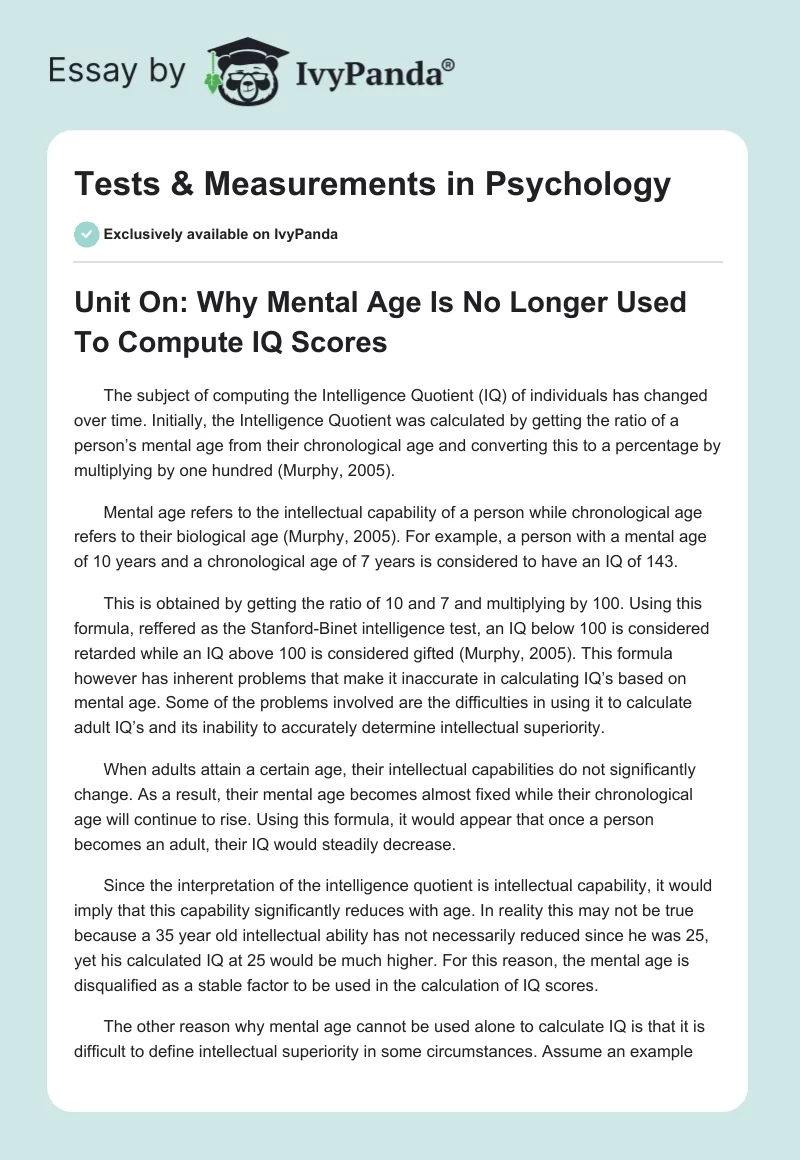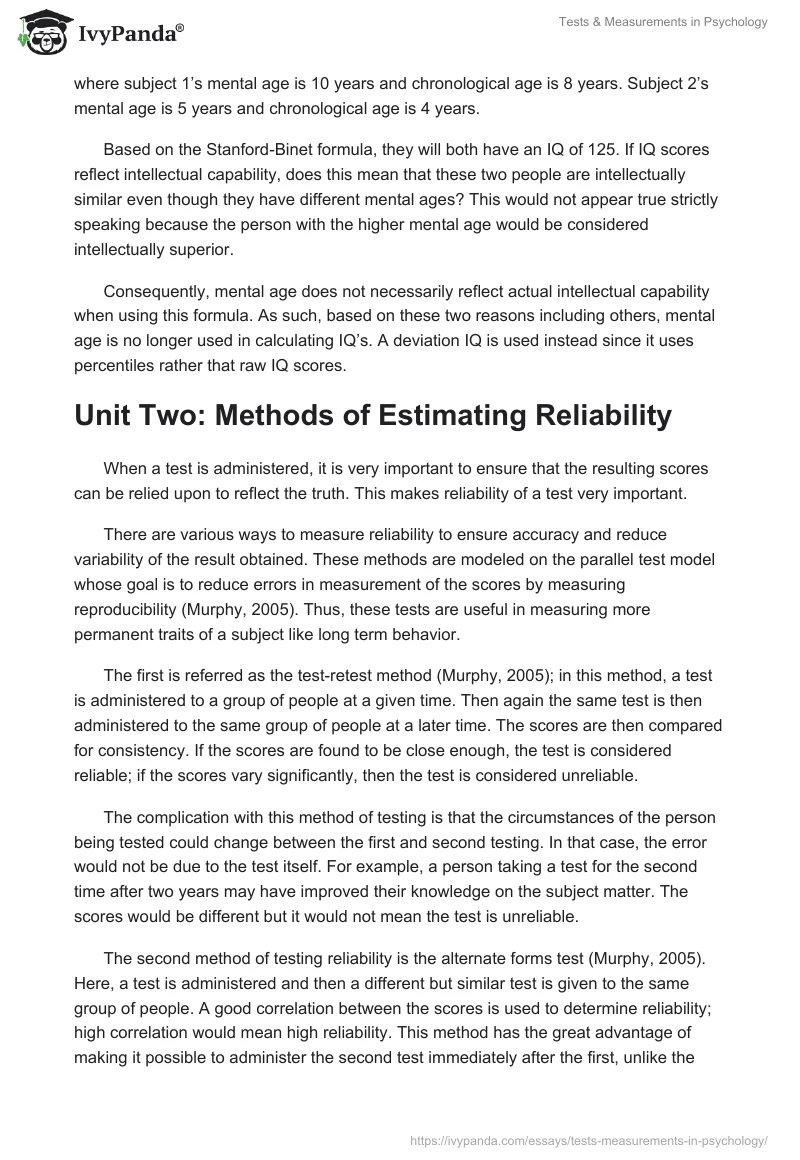Unit On: Why Mental Age Is No Longer Used To Compute IQ Scores
The subject of computing the Intelligence Quotient (IQ) of individuals has changed over time. Initially, the Intelligence Quotient was calculated by getting the ratio of a person’s mental age from their chronological age and converting this to a percentage by multiplying by one hundred (Murphy, 2005).
Mental age refers to the intellectual capability of a person while chronological age refers to their biological age (Murphy, 2005). For example, a person with a mental age of 10 years and a chronological age of 7 years is considered to have an IQ of 143.
This is obtained by getting the ratio of 10 and 7 and multiplying by 100. Using this formula, reffered as the Stanford-Binet intelligence test, an IQ below 100 is considered retarded while an IQ above 100 is considered gifted (Murphy, 2005). This formula however has inherent problems that make it inaccurate in calculating IQ’s based on mental age. Some of the problems involved are the difficulties in using it to calculate adult IQ’s and its inability to accurately determine intellectual superiority.
When adults attain a certain age, their intellectual capabilities do not significantly change. As a result, their mental age becomes almost fixed while their chronological age will continue to rise. Using this formula, it would appear that once a person becomes an adult, their IQ would steadily decrease.
Since the interpretation of the intelligence quotient is intellectual capability, it would imply that this capability significantly reduces with age. In reality this may not be true because a 35 year old intellectual ability has not necessarily reduced since he was 25, yet his calculated IQ at 25 would be much higher. For this reason, the mental age is disqualified as a stable factor to be used in the calculation of IQ scores.
The other reason why mental age cannot be used alone to calculate IQ is that it is difficult to define intellectual superiority in some circumstances. Assume an example where subject 1’s mental age is 10 years and chronological age is 8 years. Subject 2’s mental age is 5 years and chronological age is 4 years.
Based on the Stanford-Binet formula, they will both have an IQ of 125. If IQ scores reflect intellectual capability, does this mean that these two people are intellectually similar even though they have different mental ages? This would not appear true strictly speaking because the person with the higher mental age would be considered intellectually superior.
Consequently, mental age does not necessarily reflect actual intellectual capability when using this formula. As such, based on these two reasons including others, mental age is no longer used in calculating IQ’s. A deviation IQ is used instead since it uses percentiles rather that raw IQ scores.
Unit Two: Methods of Estimating Reliability
When a test is administered, it is very important to ensure that the resulting scores can be relied upon to reflect the truth. This makes reliability of a test very important.
There are various ways to measure reliability to ensure accuracy and reduce variability of the result obtained. These methods are modeled on the parallel test model whose goal is to reduce errors in measurement of the scores by measuring reproducibility (Murphy, 2005). Thus, these tests are useful in measuring more permanent traits of a subject like long term behavior.
The first is referred as the test-retest method (Murphy, 2005); in this method, a test is administered to a group of people at a given time. Then again the same test is then administered to the same group of people at a later time. The scores are then compared for consistency. If the scores are found to be close enough, the test is considered reliable; if the scores vary significantly, then the test is considered unreliable.
The complication with this method of testing is that the circumstances of the person being tested could change between the first and second testing. In that case, the error would not be due to the test itself. For example, a person taking a test for the second time after two years may have improved their knowledge on the subject matter. The scores would be different but it would not mean the test is unreliable.
The second method of testing reliability is the alternate forms test (Murphy, 2005). Here, a test is administered and then a different but similar test is given to the same group of people. A good correlation between the scores is used to determine reliability; high correlation would mean high reliability. This method has the great advantage of making it possible to administer the second test immediately after the first, unlike the test-retest where it is necessary to space the tests to prevent subjects from answering from memory.
The third method of estimating reliability is the split-half method (Murphy, 2005). This method tries to combine the first two forms; in this case a test is split into two portions depending on the responses expected. The test is then administered in one sitting. The results of the first half are compared to the results of the second half and a correlation developed.
Unlike the test-retest method, the subjects do the test in one sitting and the administrator does not have to wait for hours, days or even years to retest. Also, unlike the alternate forms testing, the subject is only subjected to one sitting and one test. This method saves time and improves the chances of having the subject in the same condition since there is no time lapse.
Lastly, reliability can be measured using the internal consistency method (Murphy, 2005). In this method, only one test is administered. Reliability is estimated based on the correlation between the different items in the test. A formula is then used to determine the degree of correlation between the items and determine how reliable the test is. Overall, all the various methods have problems that are inherent to them but still provide a way of measuring reliability; some more efficiently than others.
Unit Three: Advantages and Disadvantages of Group Tests
Group tests are tests that are administered to a large number of people at the same time. The administration and scoring is usually computerized. For example, a firm with one hundred applicants for ten positions can choose to do a group test to narrow down the applicants they hope to interview and employ. Like all other tests, group testing has its advantages and disadvantages.
Group testing offers two advantages; the first advantage is that it is very efficient (Murphy, 2005). It is a lot easier to perform group testing when there is a large number of people to test, for instance one hundred people can be tested within an hour as opposed to months if individual testing is to be employed with these one hundred individuals. The other advantage offered by group testing is standardization. Standardization can be looked at in two ways.
One view point is that every person being tested receives the same form of the test since it is usually computerized. The other view point is that there is little influence by the person administering or scoring the test. For example, if there is a chance that the person scoring the test would influence the score, it is unlikely in group testing since computerized scoring is usually employed.
There are several disadvantages to group testing; the first disadvantage is the fact that it lacks a personal touch and therefore difficult to arrive at accurate behavioral assessments that would easily be made in an individual test. For example, it is impossible to tell if a certain question invokes an emotional response from a subject yet this might have been a useful observation to make. The results are usually presented as raw scores of numbers of correct answers. It is therefore difficult to know why a person settled on a particular response.
The other disadvantage to group testing is the format that it is administered in; group testing is usually administered through multiple choice testing. Unfortunately, this does not provide the people undertaking the test with an opportunity to explain themselves because they are limited to the choices presented to them. It therefore ends up favoring people with a particular line of thinking and makes it difficult for people who are more expressive (Murphy, 2005).
On the other hand individual testing provides the opportunity for more expression due to its open-ended nature. For example, if a person’s true response happens to lie between two of the options presented in the answers, the person is forced to settle on one of them even though it does not really depict their true feeling. However, if the test was open-ended, the subject would have an opportunity to express themselves and provide a true reflection of their feelings.
Overall, group tests have a few shortcomings but in general serve an important purpose especially where large numbers of people need to be tested. It is therefore the discretion of the administrator of the test to decide on the choice of the test which will depend on the circumstances and the intended use of the results.
Unit Four: The Social and Legal Context of Employment Testing
Employment testing is a form of testing where a prospective employer subjects a prospective employee to a series of tests of various forms in order to determine eligibility for employment. These tests take on various forms including cognitive testing, medical exams or even criminal checks (EEOC, 2010).
For example, an employer seeking to hire a cashier to work by themselves on a shift may decide they need to get an honest person. As a result, they will subject their applicants to a test where they answer questions that reflect on their honesty. The employer would then pick the candidate whose score he feels displays honesty based on an established guideline. Many employment testing has both legal and social implications.
The legal implications of employment testing can be far reaching. This is because it is possible for a prospective employer to be accused of discriminating against applicants in a way that is forbidden by labor laws. A prospective employer administering employment testing should be able to justify the need for a particular skill for a job.
In such a situation, he may be able to avoid being portrayed as discriminative. For example, an employer trying to hire a housekeeper may find themselves in a bind if applicants are subjected to employment testing that includes higher than basic mathematics.
The employer may not be able to justify the need for this skill for housekeeping. Instead, the employer will appear to be discriminating against applicants who can do housekeeping yet cannot perform high level mathematics. This legal view point comes into place due to the Civil Rights Act whose aim was to protect minorities from being discriminated against by providing employers with guidelines on fair employment practices (Murphy, 2005).
Advocates against employment testing have argued that it has social implications in the sense that it takes away the idea of equal opportunity for employment. When people are recruited into employment based on their performance on a test, the employer ends up with a representative workforce. This leaves out people who may have the ability to do the job but not the ability to score on that particular test. The idea of making a person feel inadequate for a job based on a test score can easily pass for social injustice.
Most employers have good reason to administer these pre-employment tests because in most cases, these tests help them actually identify the workforce they need. In the process, it is very important for them to ensure that the legal and social implications of the testing are taken into consideration.
References
Kevin R. Murphy (2005). Psychological Testing: Principles and Applications. 6 Editn. Web.
EEOC. Org. (2010). Employment Tests and Selection Procedures. Web.


